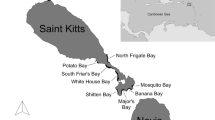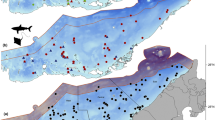Abstract
The spotted eagle ray is an iconic species for the recreational diving and snorkeling industry in the Mexican Caribbean although it is heavily fished in nearby waters of the southern Gulf of Mexico and in Cuba. This species is listed on the IUCN Red List of Threatened Species as ‘Near Threatened’ with a decreasing population trend. Few studies have reported on the populations and migrations of spotted eagle rays in the Atlantic Ocean, Gulf of Mexico and Caribbean Sea, and no regulations currently exist for the fishery or tourism industries in Mexico. Photographic identification techniques were used to produce the first photo-ID catalog of spotted eagle rays in the Mexican Caribbean using 1096 photographs submitted by researchers and divers between 2003 and 2016. In total, 282 individual spotted eagle rays were identified through photographs at nine sites across the Mexican Caribbean. Of these individuals, 14.9% were resighted at least once at the same site. The longest period between re-sighting events was 342 days. This is the first study evaluating free-swimming spotted eagle rays in the Mexican Caribbean and highlights the value of using photo-ID for monitoring populations of this ray. Because a targeted subsistence fishery for spotted eagle rays exists in nearby waters, management efforts to monitor and prevent overexploitation at key diving locations should be a priority for local government agencies.




Similar content being viewed by others
References
Ajemian M, Powers S (2014) Towed-float satellite telemetry tracks large-scale movement and habitat connectivity of myliobatid stingrays. Environ Biol Fish 97:1067–1081. https://doi.org/10.1007/s10641-014-0296-x
Ajemian MJ, Powers SP, Murdoch TJT (2012) Estimating the potential impacts of large mesopredators on benthic resources: integrative assessment of spotted eagle ray foraging ecology in Bermuda. PLoS One 7:e40227. https://doi.org/10.1371/journal.pone.0040227
Andrews KS, Levin PS, Katz SL, Farrer D, Gallucci VF, Bargmann G (2007) Acoustic monitoring of sixgill shark movements in Puget sound: evidence for localized movement. Can J Zool 85:1136–1143
Bassos-Hull K, Wilkinson K, Hull P, Dougherty D, Omori K, Ailloud L, Morris J, Hueter R (2014) Life history and seasonal occurrence of the spotted eagle ray, Aetobatus narinari, in the eastern Gulf of Mexico. Environ Biol Fish 97:1039–1056. https://doi.org/10.1007/s10641-014-0294-z
Bonfil R, Meyer M, Scholl MC, Johnson R, O’Brien S, Oosthuizen H, Swanson S, Otze D, Paterson M (2005) Transoceanic migration, spatial dynamics, and population linkages of white sharks. Science 310:100–103
Burke L, Reytar K, Spalding M, Perry A (2011) Reefs at risk revisited. World Resources Inst., Washington D.C
CONCANACO, SERVITUR (2016) Boletín Turismo. Confederación de Cámaras Nacionales de Comercio. Servicios y Turismo, México
Corcoran MJ, Gruber SH (1999) The use of photoidentification to study social organization of the spotted eagle ray, Aetobatus narinari (Euphrasen 1790), at Bimini, Bahamas: a preliminary report. Bahamas J Sci 7:21–27
Córdoba-Ordoñez J, García A (2003) Turismo, globalización y medio ambiente en el Caribe mexicano. Investigaciones Geográficas, Boletin del Instituto de Geografía, UNAM 52:117–136
Correa F, Manjarrés L (2004) Recursos de peces demersales explotados por las pesquerías artesanales marítimas de La Guajira, Caribe Colombiano. In: Manjarrés L (ed) Pesquerías demersales del área norte de Colombia y parámetros biológico-pesqueros y poblacionales del recurso pargo Univ. Magdalena, Santa Marta, Colombia, pp 77–91
Couturier LIE, Jaine FRA, Townsend KA, Weeks SJ, Richardson AJ, Bennett MB (2011) Distribution, site affinity and regional movements of the manta ray, Manta alfredi (Krefft, 1868), along the east coast of Australia. Mar Freshw Res 62:628–637. https://doi.org/10.1071/MF10148
Couturier LIE, Marshall AD, Jaine FRA, Kashiwagi T, Pierce SJ, Townsend KA, Weeks SJ, Bennett MB, Richardson AJ (2012) Biology, ecology and conservation of the Mobulidae. J Fish Biol 80:1075–1119. https://doi.org/10.1111/j.1095-8649.2012.03264.x
Cuevas-Zimbrón E, Pérez-Jiménez J, Méndez-Loeza I (2011) Spatial and seasonal variation in a target fishery for spotted eagle ray Aetobatus narinari in the southern Gulf of Mexico. Fish Sci 77:723–730. https://doi.org/10.1007/s12562-011-0389-9
Davies TK, Stevens G, Meekan MG, Struve J, Rowcliffe JM (2012) Can citizen science monitor whale-shark aggregations? Investigating bias in mark–recapture modelling using identification photographs sourced from the public. Wildl Res 39:696–704. https://doi.org/10.1071/WR12092
den Hartog J, Reijns R (2007) Interactive Individual identification system (I3S). Version 2.0. www.reijns.com/i3s
Dewar H, Mous P, Domenier M, Muljadi A, Pet J, Whitty J (2008) Movements and site fidelity of the giant manta ray, Manta birostris, in the Komodo Marine Park, Indonesia. Mar Biol 151:121–133
DOF (2012) Diario Oficial de la Federación. Carta Nacional Pesquera. Publicada el Viernes 24 de Agosto de 2012. In: Ciudad de México
Dubick J (2000) Age and growth of the spotted eagle ray, Aetobatus narinari (Euphrasen, 1790), from southwest Puerto. MSc thesis, University of Puerto Rico. p 79
Edney J (2006) Impacts of recreational SCUBA diving on shipwrecks in Australia and the Pacific, a review. Micrones J Humanit Soc Sci 5:201–233
Ellis JR, Morel G, Burt G, Bossy S (2011) Preliminary observations on the life history and movements of skates (Rajidae) around the Island of Jersey, western English Channel. J Mar Biol Assoc UK 91:1185–1192. https://doi.org/10.1017/S0025315410001906
Flowers KI, Ajemian MJ, Bassos-Hull K, Feldheim KA, Hueter RE, Papastamatiou YP, Chapman DD (2016) A review of batoid philopatry, with implications for future research and population management. Mar Ecol Prog Ser 562:251–261
González-Ramos MS, Santos-Moreno A, Rosas-Alquicira EF, Fuentes-Mascorro G (2016) Validation of photo-identification as a mark–recapture method in the spotted eagle ray Aetobatus narinari. J Fish Biol. https://doi.org/10.1111/jfb.13215
Iversen ES, Jory DE, Bannerot SP (1986) Predation on queen conchs, Strombus gigas, in the Bahamas. Bull Mar Sci 39:61–75
Jorgensen SJ, Reeb CA, Chapple TK, Anderson S, Perle C, Van Sommeran SR, Fritz-Cope C, Brown AC, Klimley AP, Block BA (2009) Fidelity, homing and population structure revealed using electronic and genetic tag in white sharks of the Eastern Pacific. Proc R Soc B Biol Sci 1155:1–11. https://doi.org/10.1098/rspb.2009.1155
Kitchen-Wheeler A-M (2010) Visual identification of individual manta ray (Manta alfredi) in the Maldives Islands, Western Indian Ocean. Mar Biol Res 6:351–363. https://doi.org/10.1080/17451000903233763
Klimley A, Butler S (1988) Immigration and emigration of a pelagic fish assemblage to seamounts in the Gulf of California related to water mass movements using satellite imagery. Mar Ecol Prog Ser 49:11–20
Kyne PM, Ishihara H, Dudley SFJ, White WT (2006) Aetobatus narinari IUCN 2013. IUCN red list of threatened species. Version 2013.1. www.iucnredlist.org
Last PR, Stevens JD (2009) Sharks and rays of Australia, 2nd edn. CSIRO, Collingwood, Vic
Lupton J (2009) The application of I3S Manta version 2.1 to the individual identification of white spotted eagle rays (Aetobatus narinari): A preliminary study
Marshall AD (2008) Biology and population ecology of Manta birostris in southern Mozambique. Ph.D. thesis. In: The University of Queensland
Marshall AD, Bennett MB (2010) Reproductive ecology of the reef manta ray Manta alfredi in southern Mozambique. J Fish Biol 77:169–190. https://doi.org/10.1111/j.1095-8649.2010.02669.x
Marshall A, Dudgeon C, Bennett M (2011) Size and structure of a photographically identified population of manta rays Manta alfredi in southern Mozambique. Mar Biol 158:1111–1124. https://doi.org/10.1007/s00227-011-1634-6
Naylor GJP, Ryburn JA, Fedrigo O, Lopez A (2005) Phylogenetic relationships among the major lineages of modern elasmobranchs. In: Hamlett WC, Jamieson BGM (eds) Reproductive biology and phylogeny, vol 3. EnWeld, NH. Science Publishers, pp 1–25
Randall JE (1964) Contributions to the biology of the queen conch, Strombus Gigas. Bull Mar Sci 14:246–295
Richards VP, Henning M, Witzell W, Shivji MS (2009) Species delineation and evolutionary history of the globally distributed spotted eagle ray (Aetobatus narinari). J Hered 100:273–283. https://doi.org/10.1093/jhered/esp005
Schluessel V, Bennett MB, Collin SP (2010a) Diet and reproduction in the white-spotted eagle ray Aetobatus narinari from Queensland, Australia and the Penghu Islands, Taiwan. Mar Freshw Res 61:1278–1289. https://doi.org/10.1071/MF09261
Schluessel V, Broderick D, Collin SP, Ovenden JR (2010b) Evidence for extensive population structure in the white-spotted eagle ray within the Indo-Pacific inferred from mitochondrial gene sequences. J Zool 281:46–55. https://doi.org/10.1111/j.1469-7998.2009.00680.x
Sellas AB, Bassos-Hull K, Pérez-Jiménez JC, Angulo-Valdés JA, Bernal MA, Hueter RE (2015) Population structure and seasonal migration of the spotted eagle ray, Aetobatus narinari. J Hered 106:266–275. https://doi.org/10.1093/jhered/esv011
Shepherd TD, Myers RA (2005) Direct and indirect fishery effects on small coastal elasmobranchs in the northern Gulf of Mexico. Ecol Lett 8:1095–1104. https://doi.org/10.1111/j.1461-0248.2005.00807.x
Silliman W, Gruber SH (1999) Behavioral biology of spotted eagle ray, Aetobatus narinari. Bahamas J Sci 7:13–20
Tagliafico A, Rago N, Rangel S, Mendoza J (2012) Exploitation and reproduction of the spotted eagle ray (Aetobatus narinari) in the Los Frailes Archipelago, Venezuela. Fish Bull 110:307–316
Van Tienhoven AM, Den Hartog JE, Reijns RA, Peddemors VM (2007) A computer-aided program for pattern-matching of natural marks on the spotted raggedtooth shark Carcharias taurus. J Appl Ecol 44:273–280. https://doi.org/10.1111/j.1365-2664.2006.01273.x
Vaudo JJ, Lowe CG (2006) Movement patterns of the round stingray Urobatis halleri (Cooper) near a thermal outfall. J Fish Biol 68:1756–1766
White WT, Last PR, Naylor GJP, Jensen K, Caira JN (2010) Clarification of Aetobatus ocellatus (Kuhl, 1823) as a valid species, and a comparison with Aetobatus narinari (Euphrasen, 1790) (Rajiformes: Myliobatidae). In: Last PR, White WT, Pogonoski JJ (eds) Descriptions of new sharks and rays from Borneo. CSIRO marine and atmospheric research, Hobart, pp 141–164
White J, Simpfendorfer CA, Tobin AJ, Heupel MR (2014) Spatial ecology of shark-like batoids in a large coastal embayment. Environ Biol Fish 97:773–786. https://doi.org/10.1007/s10641-013-0178-7
WWF (2017) Responsible shark and ray tourism, a guide to best practice. WWF, Project Aware, Manta Trust, p 87
Yamaguchi A, Kawahar aI, Ito S (2005) Occurrence, growth and food of longheaded eagle ray, Aetobatus flagellum, in Ariake sound, Kyushu, Japan. Environ Biol Fish 74:229–238
Acknowledgements
We thank the dive operators, dive associates, and underwater photographers who contributed photographs and without whom this study would not have been possible. We also would like to thank Ivan Mendez Loeza, Breanna DeGroot and Dr. Matt Ajemian for training and constructive suggestions on the project’s methods, as well as our collaborator Gabriela López Carrasco for photograph processing. We would like to thank Aquaworld, SCUBA Cancun and Solo Buceo for their ongoing assistance and field support. Funding and in-kind support for this project was provided by Disney Worldwide Conservation Fund, Save Our Seas Foundation, Mote Scientific Foundation and anonymous donors. This study was conducted in accordance with the Parque Nacional Arrecifes de Puerto Morelos regulations for conducting research in a national marine park (No. F00.9. DNAPM.422/15).
Author information
Authors and Affiliations
Corresponding author
Rights and permissions
About this article
Cite this article
Cerutti-Pereyra, F., Bassos-Hull, K., Arvizu-Torres, X. et al. Observations of spotted eagle rays (Aetobatus narinari) in the Mexican Caribbean using photo-ID. Environ Biol Fish 101, 237–244 (2018). https://doi.org/10.1007/s10641-017-0694-y
Received:
Accepted:
Published:
Issue Date:
DOI: https://doi.org/10.1007/s10641-017-0694-y




